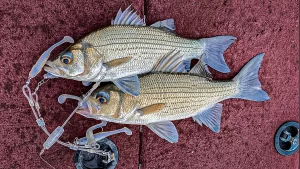White bass rank high among the most popular targets for anglers seeking a thrilling fishing adventure. Renowned for their aggressive feeding habits and spirited fights, these fish offer a rewarding challenge and can make for a tasty meal. Successfully targeting white bass often depends on knowing when and where to fish. This guide offers insights on prime locations, optimal times, and proven techniques to maximize success with this energetic species.
Understanding White Bass Habits
Both seasoned anglers and newcomers can benefit from understanding white bass habits and habitats. Originating from fisheries in east Tennessee, many have honed their skills targeting this prolific species using various techniques. White bass make for excellent targets, especially for beginners due to their abundance and spirited nature.
What Are White Bass?
Also known as silver bass or sand bass, white bass are freshwater fish native to North America, recognized for their silver-white color and horizontal black stripes. Preferring rivers, lakes, and reservoirs, they often form schools, simplifying the process of locating and catching them. White bass are predatory, showing heightened activity during the spring spawning season as they enter shallow waters to feed. Diet staples include small fish like shad and minnows as well as insects. Mature white bass typically measure 12 to 15 inches but can grow up to 17 inches.
Where to Find White Bass
White bass thrive in rivers, streams, and lakes across the country. Streams often harbor them in shallow areas near riffles and eddies. In lakes and reservoirs, focus on submerged structures such as rock piles, brush, and points, particularly during warmer months. Shallow flats become high-probability spots in the early morning and late evening as these fish move into shallow waters to feed.
Main lake points and drop-offs also make for productive spots as they provide ambush points for white bass. Since these fish tend to school together, surface activity, such as birds feeding on baitfish, can often indicate their presence. Windy areas are especially promising as wind pushes baitfish into certain areas, drawing white bass in droves.
Seasonally, target spawning areas in spring, deeper waters in summer, and return to shallower zones during the fall feeding period.

Utilizing Electronics for Success
Electronics greatly enhance the odds of locating and catching white bass. Tools like side-imaging, down-imaging, and forward-facing sonar are highly useful. White bass, known for their aggressive and abundant nature, often travel in schools that range in size from a few dozen to several hundred fish, often sticking close to structures. Recognizable on sonar, they tend to move as dense groups and exhibit fast darting motions when reacting to bait, providing valuable clues for identification.
Catching White Bass
Effective tactics for catching white bass vary by season and weather conditions. Two primary methods include shallow power fishing and deep vertical fishing. Shallow power fishing is particularly effective during the spring and fall when white bass move into shallow waters to spawn and feed. Covering water with topwater or shallow reaction baits often yields great results during this period.
In contrast, deep schools are more commonly targeted during summer and winter months, often with the aid of electronics. Hovering lures like jigging spoons or jigs and minnows above these fish often triggers bites. Depths of 15 to 30 feet are common targets, though white bass have been spotted as deep as 50 feet.
Recommended Lures
Effective lure options for white bass fishing include the War Eagle jigging spoon, Bass Pro Shops XPS Micro Spin, and Bobby Garland crappie jig paired with a soft plastic grub. The jigging spoon works well for deep schools near points or humps, while the Micro Spin excels when targeting fish close to the surface with its straightforward cast-and-retrieve approach. The Bobby Garland crappie jig is ideal for navigating brush piles and other cover.
White bass fishing offers an exciting way to land energetic, hard-fighting fish. This species provides an accessible gateway to the sport, often becoming a favorite among anglers.
Image/Source: Wired2Fish





